Classical and Hellenistic Period Glassware
The Catalogue
Classical and Hellenistic Period Glassware
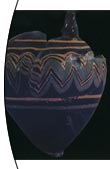 Amphoriscos
Amphoriscos
Height: 7.2 cm, Diameter of body: 5.6 cm.
Origin unknown.
Dark blue, partially transparent glass with yellow and light blue opaque helical
lines and zigzag ornamentation encircling the shoulder and body. Made using the
core-forming technique. Has a broad round shoulder, narrowing to a top-shaped
body. The neck and part of the body. The neck and part of the body and base of
vessel are broken.
Date: The Classical Age, 5th -4th century BC.
Similar Examples: Ş.Atik 1990: p.16, fig.12; Anadolu Medeniyetleri Sergi
Kataloğu, 1983: 35 B 87; B.Freyer Schauenburg, 1973:, Pl. 15 b; G. Platz
Horster, 1976, p.13 nr.9; A.Özet, 1987, p.590 fig.1; Y.Akat-N.Fıratlı, 1984,
p.19 nr.4 fig.17; P.Fossing, 1940, p.71 fig.47.
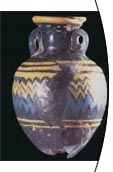 Amphoriscos
Amphoriscos
Height: 6.4 cm, Diameter: 4.3 cm.
Found in Milas.
Partially transparent, glass-green bluish glass, made by sand-casting technique.
Has yellow and turquoise glass lines and zigzag ornamentation encircling the
body. Has a round rim encircled with a ribbon of yellow glass, a short neck, and
two small handles. Top-shaped body that narrows towards the base. Surface is
highly-polished. Knob-base and a part of the body is broken.
Date: The Classical Age, 5th -4th century BC.
Similar Examples: Ş.Atik, 1990, p.16 fig. 12.
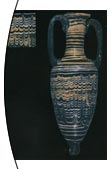 Amphoriscos
Amphoriscos
Height: 15.5 cm, Diameter of body: 5.2 cm.
Found in Stratonikeia in 1986.
Made by sand-casting from black glass. Has a collared round rim, a long neck,
well-defined shoulder, oval-shaped body, a knobbed base and two handles.
Glass-green blue colored rim, handles and knobbed base were added after the body
was completed. Yellow and white stripes encircle the neck and shoulder; the body
is decorated with a fringe pattern. Lower part of body has parallel white
stripes. Decorations on the body are slightly raised from the surface.
Date: The Hellenistic Period, 2nd -1st century BC.
Publication: A.Özet, 1992, p.114-133, fig. 2.
Similar Examples: P.Fossing, 1940, p.121, fig.94; S.Goldstein, 1979, p.129,
fig.268; Ş.Atik, 1990, p.28, fig.24; Chloe Zerwick, 1980, p.15, fig.5.
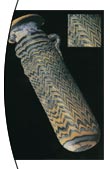 Alabastron
Alabastron
Height: 9.5 cm, Diameter of Body: 2.7 cm, Diameter of rim: 3.3 cm.
Found in Milas in 1970.
Partially transparent, glass-green blue-colored glass, with yellow and blue
opaque glass ribbons and zigzag ornamentation encircling the neck and body. Has
a short, extruded funnel-shaped rim, a very short neck, a long cylindrically
body, a rounded bottom and two small half-circle handles that look the auricles
of ears on the upper part of body. Rim is encircled with a yellow ribbon of
glass. A zigzag pattern of glass threads covers the entire surface of the body,
terminating in twists at the bottom. There is a very slightly ribbed relief
surface on the bottle. The rim and one of the handles is broken.
Date: The Classical Age, 5th -4th century BC.
Similar Examples: Ş.Atik, 1990, p.16-29, fig.17; S.Goldstein, 1979, p.127
Nr.263; P.Fossing, 1940: 67 fig.41; A.Topbaş, 1992, III. Müze, p.1-30 fig.33.
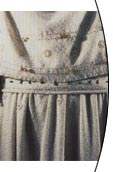 Beads
Beads
Height: 0.7 cm (astragal-shaped), Diameter: 0.4 cm, Height: 0.6 cm
(barley-shaped), Diameter: 0.3 cm.
Found in the tomb of the Karian princess in 1989. Excavation inventory number:
A.B.20/89.
22 blue colored astragal-shaped beads and 8 barley-shaped beads, found in the
Tomb of the Karian Princess in Yokuşbaşı-Bodrum. Have a cord-hole in the middle
and are made by casting. Astragal-shaped beads have narrow side faces between
the front and two back faces. Barley-shaped beads are cone-shaped. The
barley-shaped beads were most likely arranged horizontally and the
astragal-shaped beads of the same shapes were also recovered from the Karian
tomb. There is some weathering on the surface of the beads.
Date: The Classical Age, Mid-4th century BC.
Publications: M.A.Özet, 1992, p.101-112; M.A.Özet, 1994, p.88-96
Similar Examples: A.von Saldern, 1980, p.107-109 fig.841-842-845.
Aryballos
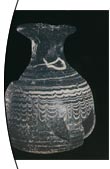 Height:
9.7 cm, Diameter of Rim: 4.7 cm.
Height:
9.7 cm, Diameter of Rim: 4.7 cm.
Found in Köyceğiz.
Green-glass blue-green colored, partially transparent glass, encircled with
white glass threads, made by sand-casting. Has an extruded, funnel-shaped rim, a
short neck and an onion-shaped body. There is a tool mark at the edge of rim.
The rim and neck are thicker than the body. Glass threads trail the bottle in a
fringe pattern and form a bow-tie at the neck. One side of the body has been
pushed out of shape by pressure. There is weathering on the surface and the
trailing threads.
Date: The Hellenistic period, 3rd -2nd century BC.
Similar Examples: P.Fossing, 1940, p.124-126, fig.99-103.
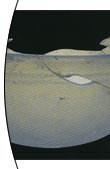 Bowl
Bowl
Height: 7 cm, Diameter of Rim: 12.9 cm.
Found in the excavations of Kaunos in 1974. Excavation inventory number: 68/172.
Bright green, partially transparent glass, with a few air bubbles. Made by
pressing inside a closed mold, later polished. Has a hemispherical shape,
extruded rim, and the tracings, one inside the other, around the base. Piece was
polished by lathe-cutting. Around rim are some broken edges and missing parts;
one crack has been glued.
Date: The Late Hellenistic Period, 2nd -1st century BC.
Similar Examples: S.Goldstein, 1979, p.138, fig.282; A.von Saldern, 1980, p.6;
Y.Akat - N.Fıratlı, 1984, p.22, fig.31; M.Stern, 1989, p.597; M.De Jullis
Ettore, 1989, p.249 fig.48.